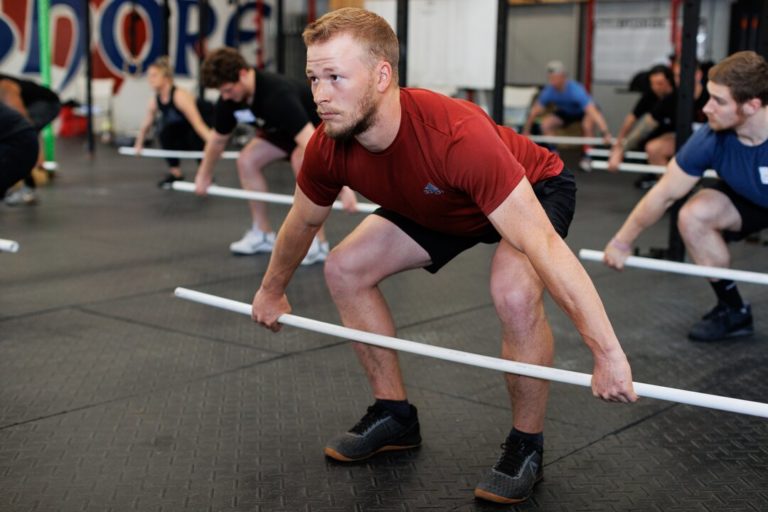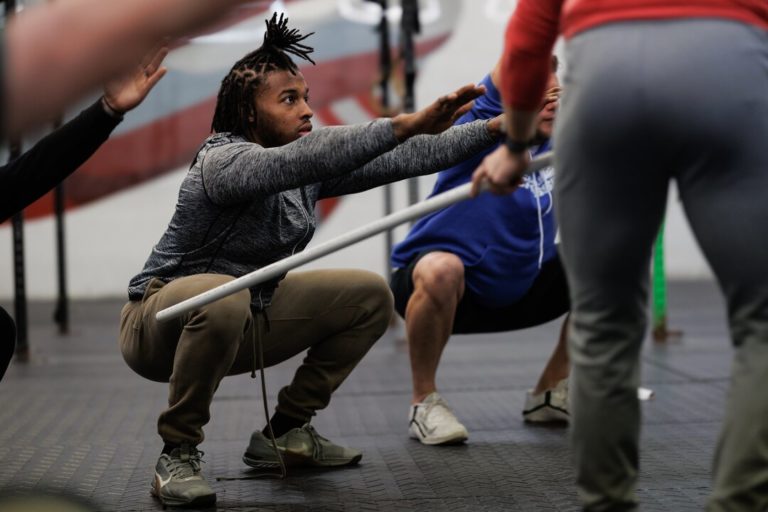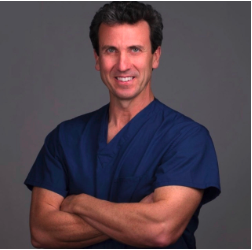Nagging knee pain is a hindrance for anyone and often prevents the pursuit of an active lifestyle — whether that be playing a sport or taking a walk around the block each day. Fear of instigating more pain or becoming injured could lead someone to believe that using their knees as little as possible — translation: staying sedentary — is the best option.
Sean Rockett, M.D., a sports medicine orthopedic surgeon and Healthcare Professional Level 2 CrossFit Trainer (HCPL2), disagrees and asserts that with proper movement patterns under the watchful eye of a healthcare professional and credentialed coach, knee pain should not prevent anyone from participating in exercise.
In this article, Dr. Rockett covers some of the most common ailments he sees in people experiencing knee pain and offers options for approaching recovery.
Why Does Knee Pain Happen?
Most often, knee pain occurs as a result of overuse, injury, or degeneration, and can happen over time or as a result of an acute injury. Oftentimes, people think knee pain is permanent and treatable only with surgery. While surgery is sometimes warranted, some knee pain can be treated with physical therapy and proper movement patterns to keep the joint and tendons strong and healthy while recovering.
For someone who does CrossFit or is interested in starting CrossFit, knee pain can be particularly cumbersome when thinking about squatting, jumping, and running, as a few examples. However, under the care of your healthcare professional as well as a credentialed CrossFit coach, pursuing fitness through movement modifications while experiencing knee pain is possible and even beneficial to the healing process. Through physical therapy, modifications, and thoughtful scaling, you can continue to maintain fitness through injury. Contrary to the belief that degeneration as a cause of knee pain is simply due to the clicking of time, proper training can actually help prevent tendons and muscles from breaking down prematurely.
Common Complaints
Tendonitis
Knee tendonitis is a common ailment that can occur in any tendon of the knee, including the patella tendon, iliotibial band, quadriceps tendon, and hamstring tendons.
These tendons can be affected if someone is too aggressive in their approach to squatting, jumping, or running. In CrossFit, we teach mechanics first, then consistency, and only when those two are mastered is intensity pursued. Dialing in form and repetition is necessary to prevent injury when racing against the clock.
“Establishing sound mechanics of a movement and consistently repeating those sound mechanics before placing an emphasis on increasing intensity via load, reps, or speed has been CrossFit’s longstanding charter of introducing individuals to the program, learning new movements, and rebounding back from injuries,” says Level 4 CrossFit Coach and CrossFit Seminar Staff Trainer Eric O’Connor. “Through a slow and steady approach to development, athletes will garner the long-term results they want and decrease the risk of injury.”
A hallmark of tendonitis is that it often does not occur from an acute injury, but rather there is a sudden onset of stabbing pain a day or two after a long bout of activity. The pain can magnify over weeks to months if the tendon continues to be irritated and micro-tears develop. Disregarding the pain completely will worsen the condition — consider the quote, “No snowflake in an avalanche ever feels responsible.”
Tendinopathy can be graded on a spectrum of mild to severe. Mild pain may occur the day after running a mile, but not during the actual run. Moderate pain occurs in the beginning of a warm-up, but loosens up and feels better during activity, and then recurs after the workout. An example of severe pain is pain that doesn’t allow the person to sleep or they have trouble bending their knee or climbing stairs.
Generally, treatment for tendonitis is directed at lowering the pain level and stress on the knee to allow the tendons to heal. This does not mean becoming sedentary, but rather modifying activity to a level that allows recovery of the injured body part.
 If knee pain is preventing you from squatting, strengthening the tendon in other ways is helpful. If it hurts to run or jump, try biking, rowing, or swimming, as these allow for cardiovascular exercise without the impact. In CrossFit, modifying is celebrated as a way to remain active while healing from injury, working toward new skills, or maintaining intensity relative to capacity. To the contrary, overworking an injured body part and pushing through physical pain is not celebrated in CrossFit; rather, it is detrimental to the health of any athlete striving for fitness in the long term. When the time comes, returning to normal activity slowly and increasing the duration and intensity of exercise over time will serve any athlete well.
If knee pain is preventing you from squatting, strengthening the tendon in other ways is helpful. If it hurts to run or jump, try biking, rowing, or swimming, as these allow for cardiovascular exercise without the impact. In CrossFit, modifying is celebrated as a way to remain active while healing from injury, working toward new skills, or maintaining intensity relative to capacity. To the contrary, overworking an injured body part and pushing through physical pain is not celebrated in CrossFit; rather, it is detrimental to the health of any athlete striving for fitness in the long term. When the time comes, returning to normal activity slowly and increasing the duration and intensity of exercise over time will serve any athlete well.
Arthritis
Arthritis is one of the most common reasons people visit their doctor. The term “arthritis” refers to a loss of cushion in a joint where bone is exposed — think of a sofa without the cushions. Instead of a smooth surface, a rough sandpaper develops as the cushion deteriorates.
There is a condition called patellofemoral syndrome which typically causes pain in the front of the knee under the kneecap. It can be a sign of stress on the kneecap and sometimes shows up normal on X-ray and MRI. If you lose cushion under the kneecap, patellar arthritis can develop. Treatment generally consists of physical-therapy exercises to stretch the tight structures, strengthen the weak structures, and avoid severe pain while recovering. Some of these exercises include the couch stretch, the Spiderman stretch, and banded quad resistance exercises. If you’re still going to the gym through injury, limiting load and volume and working through a (potentially limited) pain-free range of motion in squats and deadlifts can support your recovery.
Arthritis can cause pain with squatting or running. Sometimes the pain is felt on the inner (medial) side of the knee and sometimes the outer (lateral) side. Symptoms can be mild to severe. Mild pain is characterized as aching and throbbing after intense activity, and severe pain can be determined when it occurs with standing, walking, climbing stairs, or even sleeping. Treatment includes bracing for support if the knee is swollen, physical therapy, Tylenol, anti-inflammatories, aspiration of the knee (a procedure that sucks fluid from your knee) if swelling does not improve, injections, or knee replacement if conservative measures fail.
Tears
Meniscal tears are the most common tears that occur in the knee. These can occur from a fall or from a sudden twisting or turning, like you might see in certain sports. Tears in the meniscus can cause a sharp pain with a catching sensation.
Meniscus tears can begin to heal on their own without surgery. Certain tears and scenarios warrant operative treatment, but conservative measures should be exhausted first. If someone has a tear but does not have pain, surgery is not required. If there are mechanical symptoms like buckling, giving way, or locking, surgery may be needed.
Working in collaboration, your healthcare professional and credentialed CrossFit trainer can determine limitations when it comes to physical activity. The guiding tenet is not to push through physical pain. Experiment with certain movements during the warm-up to make sure they do not cause pain. Keep the weights light initially while testing movement. For meniscal tears, squatting to a box that allows your squat to be at or above 90 degrees may be tolerated, and jumping and landing may be restricted if they cause discomfort.
Ligament Injury
Injuries to the ligaments in the knees can occur when undue stress is placed on the medial collateral ligament (MCL) or the anterior cruciate ligament (ACL). These injuries can occur when the knees collapse inward in a movement as opposed to staying aligned over the feet, for example.
 A credentialed CrossFit trainer can help you maintain proper form during all CrossFit movements to prevent ligament injuries from occurring. They may also instruct you to avoid jumping and substitute biking or rowing, which are safe with a torn ACL. If there is significant laxity and someone cannot restrict pivoting or twisting — such as in sports like basketball, soccer, or skiing — then surgery is reasonable.
A credentialed CrossFit trainer can help you maintain proper form during all CrossFit movements to prevent ligament injuries from occurring. They may also instruct you to avoid jumping and substitute biking or rowing, which are safe with a torn ACL. If there is significant laxity and someone cannot restrict pivoting or twisting — such as in sports like basketball, soccer, or skiing — then surgery is reasonable.
The knees are complex joints, and while injury is always possible, so is rehabilitation and healing under the care of your healthcare professional. A qualified CrossFit coach can collaborate with your doctor to help guide your return to activity and pursuit of fitness.
 Sean Rockett, M.D., is an orthopedic surgeon and senior partner of Orthopedics New England in Natick, Massachusetts. Dr. Rockett is a
Sean Rockett, M.D., is an orthopedic surgeon and senior partner of Orthopedics New England in Natick, Massachusetts. Dr. Rockett is a